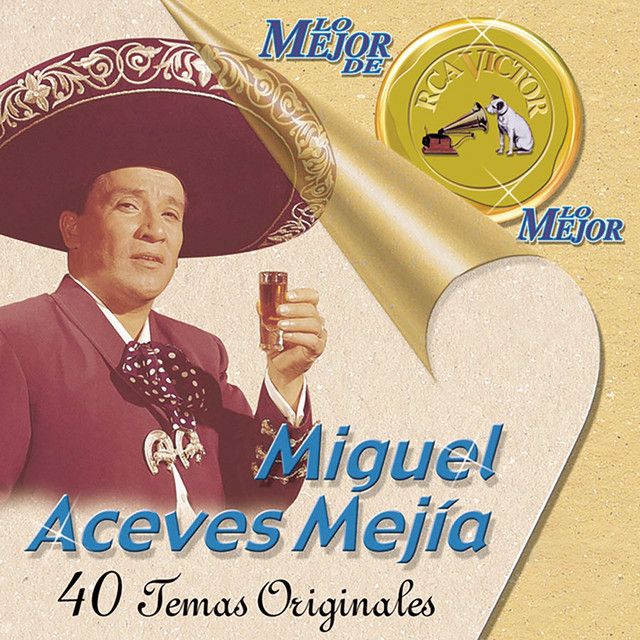
Some of Miguel Aceves Mejia's most popular songs include La Malagueu00f1a, El Pastor, Cielo Rojo. These tracks have impressed fans and helped cement their place in the music industry.
Bolero

Upcoming Miguel Aceves Mejia Tour
No Upcoming events as of now
Follow artist to get all the updates
Known as "The Golden Falsetto," Miguel Aceves Mejia achieved the peak of his success as a ranchera and film star in the late '50s. His early career breaks were in radio, where he got a gig singing on a show sponsored by his auto factory boss, which led to a gig at the legendary Monterrey station XET. There he formed a trio with Emilio Allende and Carlos Sorolla, later moving to Los Angeles to pursue a solo career. It was there he developed the falsetto singing style that became his trademark. In 1940, he relocated to Mexico City for another radio job, this time at XEW. Mejia signed a contract with RCA and began issuing recordings with them in the mid-'40s. He initially recorded tropical music, but a studio musicians' strike led him to record with a mariachi band instead. The style suited him and his songs started to earn him some attention, leading to his first film role, in 1947's De Pecado en Pecado, where his voice was dubbed over actor José Pulido's singing parts. He got his first major role seven years later in Los Cuatros Vientos and was an instant movie star. He would eventually appear in more than 40 films alongside great Mexican stars like María Felix, Pedro Armendariz, Lola Beltrán, and Amalia "La Tariácuri" Mendoza of Trio Tariácuri. His constant visibility in films also helped ensure a steady stream of hits, including several songs written by José Alfredo Jimenez, including "Perla," "Cuatro Caminos," and "Alma de Acero." His versions of several traditional rancheras are also well known, including "Hay Unos Ojos," "Paloma Negra," "La Malagueña," "Cucurrucucu Paloma," "El Jinete," and "Canción Mixteca." ~ Stacia Proefrock
Read moreKnown as "The Golden Falsetto," Miguel Aceves Mejia achieved the peak of his success as a ranchera and film star in the late '50s. His early career breaks were in radio, where he got a gig singing on a show sponsored by his auto factory boss, which led to a gig at the legendary Monterrey station XET. There he formed a trio with Emilio Allende and Carlos Sorolla, later moving to Los Angeles to pursue a solo career. It was there he developed the falsetto singing style that became his trademark. In 1940, he relocated to Mexico City for another radio job, this time at XEW. Mejia signed a contract with RCA and began issuing recordings with them in the mid-'40s. He initially recorded tropical music, but a studio musicians' strike led him to record with a mariachi band instead. The style suited him and his songs started to earn him some attention, leading to his first film role, in 1947's De Pecado en Pecado, where his voice was dubbed over actor José Pulido's singing parts. He got his first major role seven years later in Los Cuatros Vientos and was an instant movie star. He would eventually appear in more than 40 films alongside great Mexican stars like María Felix, Pedro Armendariz, Lola Beltrán, and Amalia "La Tariácuri" Mendoza of Trio Tariácuri. His constant visibility in films also helped ensure a steady stream of hits, including several songs written by José Alfredo Jimenez, including "Perla," "Cuatro Caminos," and "Alma de Acero." His versions of several traditional rancheras are also well known, including "Hay Unos Ojos," "Paloma Negra," "La Malagueña," "Cucurrucucu Paloma," "El Jinete," and "Canción Mixteca." ~ Stacia Proefrock

Some of Miguel Aceves Mejia's most popular songs include La Malagueu00f1a, El Pastor, Cielo Rojo. These tracks have impressed fans and helped cement their place in the music industry.

You can listen to Miguel Aceves Mejia's music on all major streaming platforms, including Spotify, Apple Music, and YouTube. Their most popular songs include La Malagueu00f1a, El Pastor, Cielo Rojo, and more.

Miguel Aceves Mejia is known for their distinctive sound in the bolero genre, often blending elements of mariachi, making them a unique voice in the music world.

You can find the ticket details about Miguel Aceves Mejia concert from AllEvents.